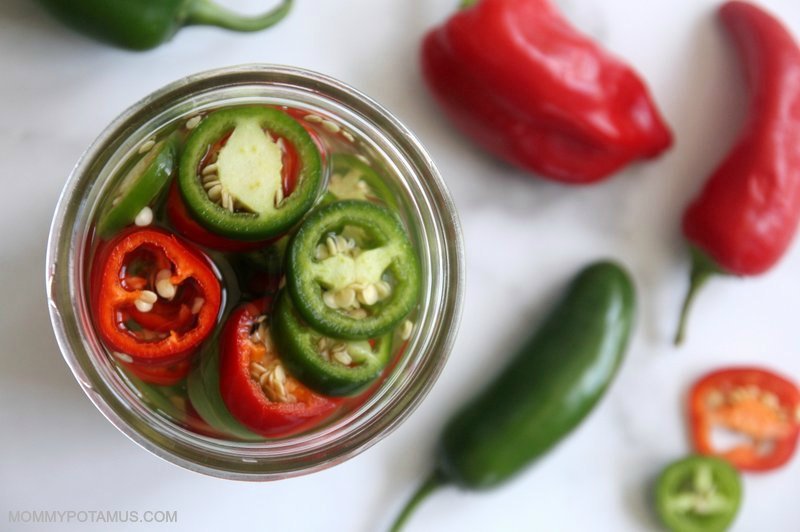
In my house, there are four words that always go together – “fermented jalapeños” and “MORE PLEASE.” Whether it’s Mexican 8 layer dip, nachos, tacos, chicken tortilla soup recipe or even cheesy cauliflower crust pizza, these fermented jalapeños are a crowd-pleasing, delicious way to add a pop of flavor to all kinds of favorite dishes.
They taste very similar to the pickled jalapeños sold in stores, but In addition to tons of flavor, they’re also rich in two things not found in the pickled version:
- Probiotics (beneficial bacteria) that support gut health, immune function, and more.
- Vitamin C, which supports skin collagen production and “various cellular functions of both the innate and adaptive immune system.” Technically, pickled versions have a tiny bit, but most is destroyed via heat. Fermented jalapeños aren’t heated so they retain more vitamin C, and fermentation actually increases vitamin C content. (1) (2) (3)
Jalapeños are also rich in capsaicin, a powerful antioxidant and anti-inflammatory compound (4) Oh, and you can make them with just 10 minutes of hands-on time and four easy steps (plus a few days of ignoring them while the probiotic magic happens).
Here’s how:
- Make a saltwater solution (stir salt into filtered water)
- Chop your jalapeños and peel a clove or two of garlic
- Put the saltwater and veggies together in a jar
- Make sure the veggies are submerged, secure the lid, and let them ferment for 3-5 days
Benefits of Fermented Jalapeños
If you’ve ever made kimchi, sauerkraut or beet kvass, you’re probably familiar with the process of lacto-fermentation. It’s when beneficial bacteria (lacto is for lactobacillus) are used to extend shelf life (aka preserve) them by inhibiting the growth of harmful bacteria.
The process works because lactobacillus are tolerant to salt while the bad guys can’t take much of it.
When we put a veggie and salt in water, the good bacteria consume some the carbohydrates found in the veggies and convert it into lactic acid. The production of lactic acid is what gives fermented foods like pickles and sauerkraut their delicious tangy flavor. It also inhibits other organisms and is one of the primary ways people have preserved food for generations.
Here are some of the benefits of this approach:
- Makes some of the nutrients in jalapenos more bioavailable
- Lactobacillus bacteria increase vitamin C levels during fermentation
- Introduces probiotics into the mix, which support the immune system and gut health
- Many strains of lactobacillus make vitamin K, which increases the nutrient profile when present (5)
Do I need special fermenting equipment?
When I started culturing vegetables I used mason jars and lids, but sometimes my batches molded instead of fermenting properly. That’s because most fermented foods do best in an anaerobic (low oxygen) environment. Fortunately, even though you do need an airtight jar and something to hold the veggies down with, there are a few simple options that will work.
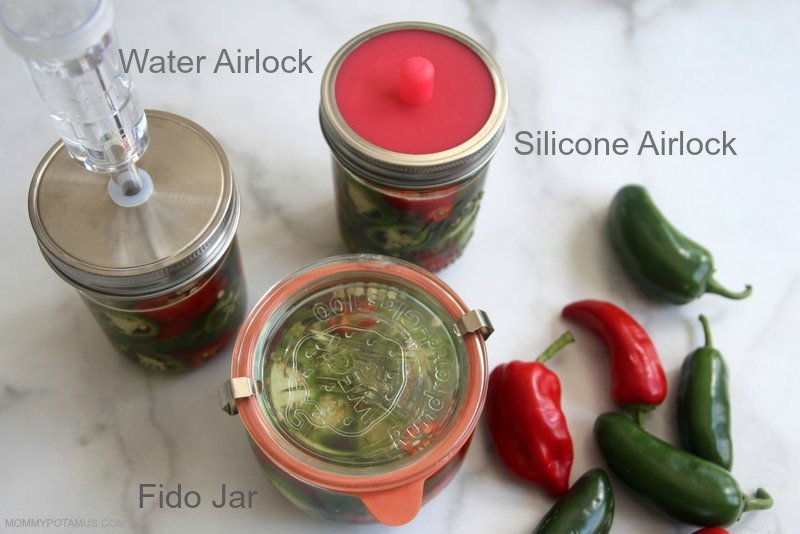
Option #1: Mason Jar With Silicone Lid
When fermentation is going well, the saltwater brine will start to bubble as the good bacteria consumes carbohydrates and creates carbon dioxide. This process is what makes drinks like homemade ginger ale bubbly. In other words, it’s a sign of a healthy ferment. (It’s also a good sign if the brine becomes slightly cloudy.)
However, if your jar doesn’t have a way to release some of the carbon dioxide it can build up too much and cause the jar to burst. For that reason, I LOVE these soft silicone lids that allow excess carbon dioxide to escape without letting oxygen in. They fit on regular mason jars and are the most low-maintenance airlocks I’ve ever used. (You use the metal rings that come with mason jars to secure them in place.)
Option #2: Mason Jar With Airlock
This is a special airlock lid that fits on any wide-mouth mason jar and uses water as a seal. I’ve put together a step-by-step guide for using them in this tutorial for making beet kvass.
Option #3: Medium Fido Jar
A fido jar is a glass jar with a thick rubber gasket that held in place by the lid. The rubber helps create an anaerobic environment for the good bacteria to grow in. As the fermentation process progresses little gas bubbles will start to form in the liquid.
Since they don’t have a way to escape in an airtight environment, you’ll want to “burp” the jar (aka open it for a sec) every couple of days to release the pressure. Here’s where to find a fido jar.
You’ll Also Need:
- Fermentation weight (If you don’t have a fermentation weight, you can use a thin, smooth stone that has been boiled for 5-10 minutes and allowed to cool fully)
- Washable chalkboard pen (Optional – See tips below for how to use)
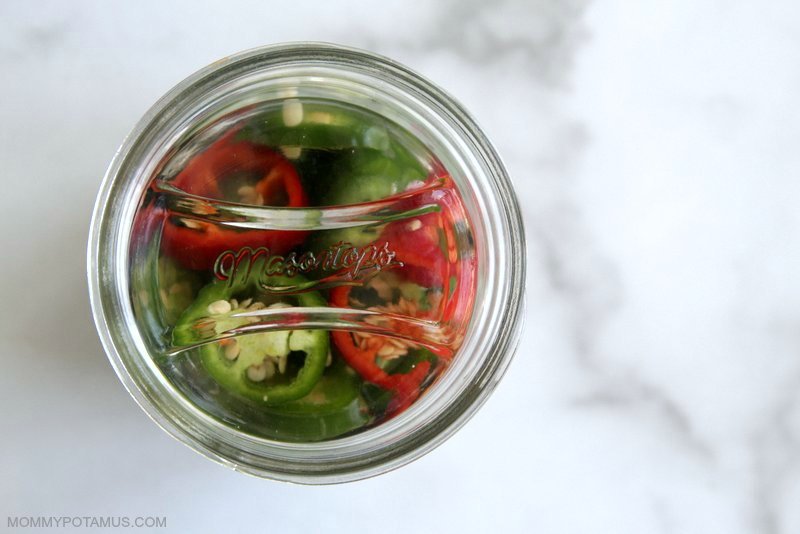
Helpful Tips
- Use non-chlorinated water, because chlorine kills the good bacteria you want to culture.
- To take the heat of the jalapeños down a notch, remove most of the seeds before you place them in the jar
- Make sure to use clean jars and equipment. You want them to be free of microbes that might interfere with the good guys we are trying to culture. To get everything ready you can run it through the dishwasher with hot water (preferably using the “sanitize” setting) OR you can pour boiling water into the jars/vessels you are planning on using and use hot, soapy water to clean everything else. I keep my extra clean jars in a particular spot in my kitchen so that I can grab them when needed.
- Use a washable chalkboard pen to write the “ready on” date directly on your jars so they’re easy to keep track of.
Also, this is not a tip, but I do want to mention that as the jalapeños ferment they’ll change from bright green or red to a more olive green or soft red. The end result should look similar to pickled jalapeños sold in stores.
Lacto-Fermented Jalapeños Recipe
Equipment
- Two 16 ounce mason jars with fermenting lids (Or a 16-17 ounce fido jar)
- Fermentation weight*
Ingredients
- 10-12 ounces whole green or red jalapeños (by weight, or roughly enough sliced jalapeno jars to fill two 16 ounce mason jars 75% full)
- 2 cloves garlic
- 2 tsp teaspoons finely ground sea salt**
- 2 cups filtered water
Instructions
- Wash the jalapeños and trim the tops off. Slice them into rounds.
- Place one clove of garlic into your first jar, then add jalapeños rounds until the jar is 3/4 full. Repeat the process with the second jar.
- Place fermentation weights over the jalapeños.
- Make your brine by stirring together the salt and filtered water. Divide the brine between the two jars – you'll want enough to fully cover the jalapeños, plus a little more above the fermentation weight.
- Secure the lid and set up the airlock if you're using one. (Here's a step-by-step photo tutorial that shows how to set up and airlock.)
- Allow the jar to ferment at room temperature for 3-5 days. Keep it out of direct sunlight – I keep mine in one of my kitchen cabinets. If you're using a fido jar, you'll need to "burp" it (open it up) every couple of days to release the gases that build up, and if you're using an airlock you'll want to check on it periodically to make sure that the water which forms the seal hasn't evaporated. The color may change to a more caramel tint throughout the process – that's normal.
- Taste it throughout the fermentation process, and when it reaches a flavor that you like transfer it to the fridge. If you're using a lid with an airlock, replace it with a regular mason jar lid before storing it. I have a batch from a large harvest over a year ago that is still good!
Notes
Nutrition
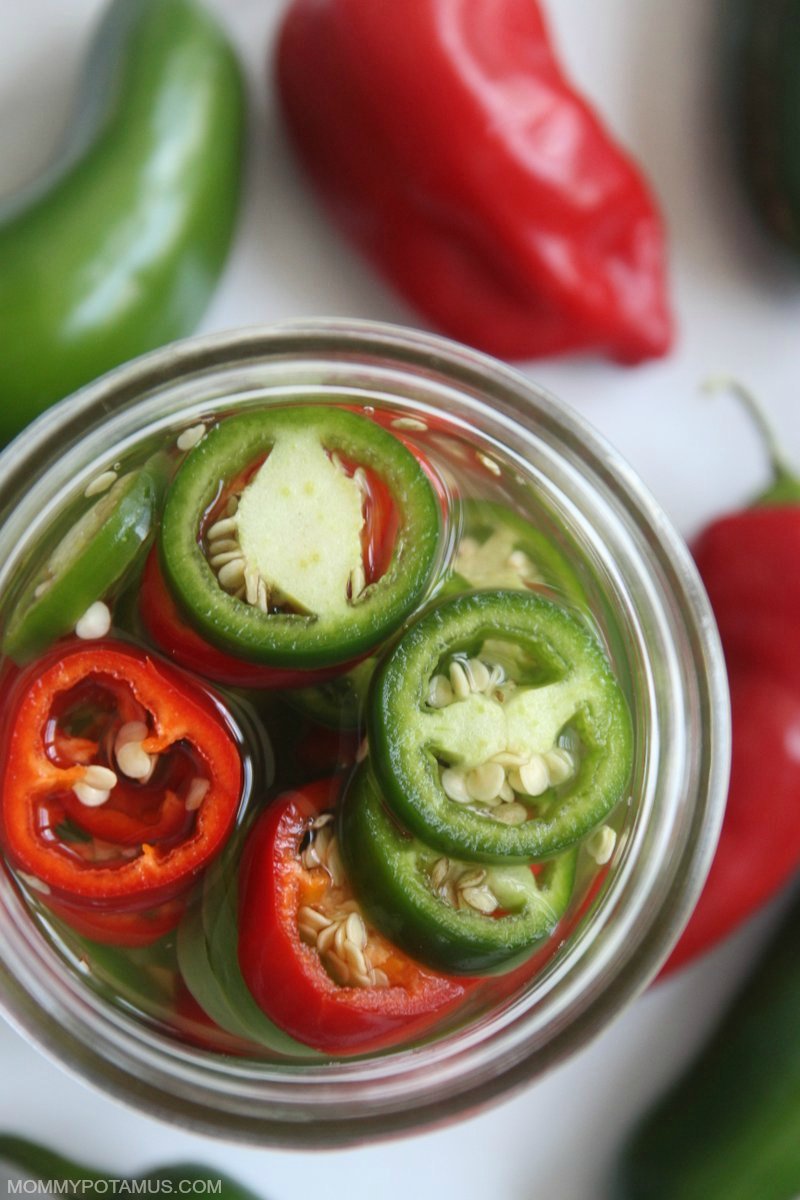
Frequently Asked Questions
What’s the difference between fermenting and pickling?
Pickling involves soaking foods in an acidic liquid like vinegar to create a sour flavor, while fermenting achieves a sour flavor via the probiotic conversion of carbohydrates to lactic acid. Fermented foods are probiotic-rich, while pickled foods do not contain probiotics.
How long these keep for?
I’ve had batches last for over a year. However, because veggies continue to ferment very slowly in the fridge they can eventually become more sour or softer than you might like. I would shoot for using up a batch within 6-12 months. I have never had a batch go bad in the fridge but it is possible, so if it seems off it’s best to toss it.
Sources
1. DePhillipo, Nicholas et. al. (2018) Efficacy of Vitamin C Supplementation on Collagen Synthesis and Oxidative Stress After Musculoskeletal Injuries: A Systematic Review
2. Pullar, Juliet et. al. (2017) The Roles of Vitamin C in Skin Health
3. Carr, Anitra and Maggini, Sylvia (2017) Vitamin C and Immune Function
4. Zimmer, Aline et. al. (2012) Antioxidant and anti-inflammatory properties of Capsicum baccatum: From traditional use to scientific approach
5. Liu, Yue (2019) Long-chain vitamin K2 production in Lactococcus lactis is influenced by temperature, carbon source, aeration and mode of energy metabolism

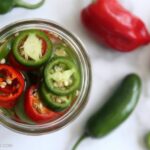
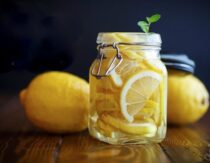
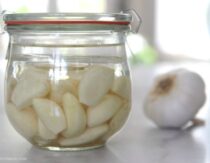
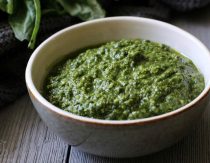

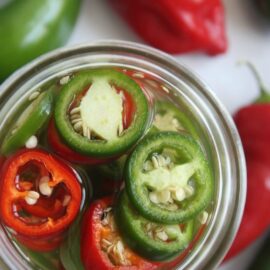
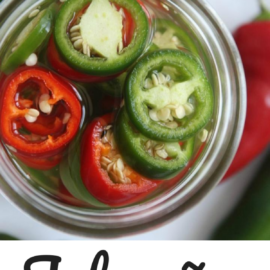
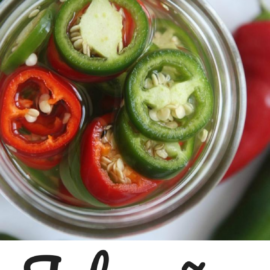
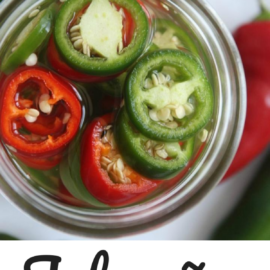
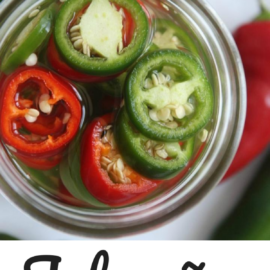
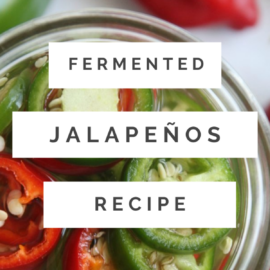
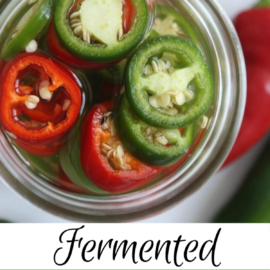
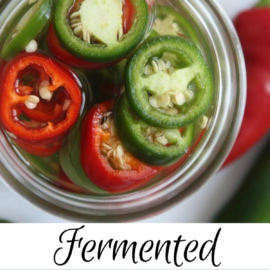
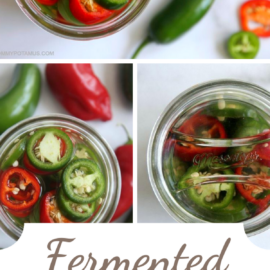
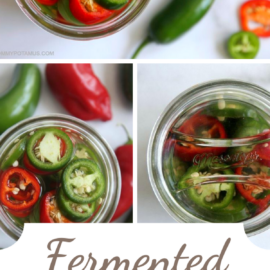
Awesome. Chet loves to put these on bus meals! Thanks.
You’re welcome, Margo! They’re really easy and I know he’ll love them!
Do you remove lid after shaking? Do you cover with lid in fridge?
Thank you
Hi Kyra, I keep the lid on after shaking and in the fridge. If you leave the jar out on the counter for a long time (more than 5-7 days), you’ll want to periodically “burp” the jar by lifting the lid so it doesn’t fill with pressure.
I love that this is so easy! And I have some jalapenos that I can go try it with right now!! Thank you!
Yes, this recipe is SO EASY, but they are really good, too! I almost didn’t post it because I sat down to have a few and almost ate half a jar in one sitting. There were almost not enough left to photograph!
I am doing couliflour with jalopanos and bell pepper. I used sea salt. It has been 3 days and the water is cloudy. I am using air locks. I s it ok?
Hi Sharon, without reviewing and testing the ratios of all the ingredients and the amount of salt used I can’t really say, sorry.
Cloudy is natural and normal for this process
Wow, these look so easy! I’m about to make the pickled garlic- I bet these would look pretty on the counter next to each other : )
I can’t believe how easy that is! I can’t wait to try this! Thanks so much, Heather!
Do you just leave the jar on the counter or put in a dark cool place for the fermenting process?
I put mine in a cabinet 🙂
I usually put the jars in a closet that is cool and dark. Every year I make fermented yellow squash, jalapenos, – cucumbers, – and bok choy kimchi … and these sit in the basement for about 2 to 3 weeks. Just remember; the higher the temp the faster the ferment process. I like to do the process slow as it gives time for the bacteria to “eat” deeper into the pieces.
The result with yellow squash is wonderful. It becomes acidic and sweet. (add sweet onions and mushed up garlic along with dill. I like garlic so I use an entire bulb. )
I also suggest using the “weighted plates” that keep the produce under the brine and I always use an airlock.
I’ve tried using olive oil to block out the oxygen by pouring enough over the brine so that air cannot get to the produce. Remember: this fermentation process is “without oxygen” or “anerobic”. The use of olive oil resulted in a great end product. with no mold.
After I do hot peppers or the cucumbers etc…
I usually do either a “hot water bath” canning process or a pressure canning process to preserve the foods over a long time- not needing refrigeration afterwards. Which process I use depends on the acid level that I get at the end of the ferment process. I have a Ph meter to make sure.
but what do I know? I”m a chile brain or pepper head. I’m addicted to hot stuff.
Sunlight and certain indoor lights (like some flourescent lights, halogens, and LED’s, produce ultraviolet light. UV light is not good for the bacteria.)
good luck and good eating !!
oh yeah… always use salt. Non iodized salt or “canning salt”.
If you use a hot water bath to seal your jars, haven’t you just lost the benefits of fermentation via the heating/cooking process? Isn’t that why we take the trouble to ferment instead of buying or making pickles?
Yes. probiotics are gone.
P.S. I had a stomach bug 3 weeks ago, so maybe my body is craving these as a recovery food? I could care less about plain jalapenos, they MUST be cultured. Thoughts?
Are the floating seeds going to mold during the fermenting stage?
Peppers are also high in Vit. C.
These look great btw, I’ll have to remember them for next summer when we have peppers.
I have been eating a lot of pickles lately too…..and definitely not pregnant here either!
Interesting, Kristine Winniford! I’ll bet that’s part of the reason for sure. Normally I like to eat in season, but I just can’t get enough right now. Back to the store I go!
My dad and I both crave kraut when getting over a stomach bug. I’ll even add extra salt sometimes! Perhaps something to do with rebalancing electrolytes?
Hubby and I just looked through your website and I will be making all of it:-) looks so good.
Heather, what’s the difference between pickled food and fermented? I was always eating pickled food is bad for you. I know you know how to clarify it for me. Will you please?
Was always “told”
Pickled items are prepared in a vinegar brine while fermented are prepared in salt. These are really fermented . . . I just couldn’t resist the reference to one of my fave tongue twisters 🙂
Hahaha! Love it!
Hi Heather, I am so inspired by your post that I am making these today. But I am wondering, why no whey in the recipe? I’ve made one other Sally Fallon recipe (pickles) without whey (didn’t have any at that time) so I used the extra salt instead, and they were awful. So salty and rotten tasting…dumped it all. I want to ferment again but would like to use whey since I hate to dump another batch of anything, though yours obviously turned out good without it. Just wondering if they’d be better/healthier with or without whey, or maybe this recipe should be whey-less for some reason? Thanks for all the wonderful recipes…your site is great!
Hi Angelina! Some experts on fermentation say that allowing the native beneficial bacteria to develop naturally is usually better than using an outside starter, especially if that starter is a different bacterial strain.
So the whey isn’t need to ferment, it simply keeps it from going bad while the fermentation is in process. Maybe that was the problem with my pickles? The extra salt didn’t keep them from going rotten like whey would have, I’m guessing. I’m off to make a peck of pickled peppers now! Thanks for the fast reply!
Actually, it’s the reverse. Salt keeps food from spoiling while the whey ferments. But in some cases all you need is a little salt to prevent spoilage and the fermenting will happen on its own. Pickles are tricky- I’ve found that they really turn out best if you use an airlock to keep mold out 🙂
Right, I should have known that! I had an abundance of jalapenos, so I made one jar with just salt, one with whey, just to see if anything different happens (who doesn’t love a science experiment?). Also made a jar of ginger carrots since they sound so yummy, but I had a little pre-taste of them and they are so salty. I’ve heard that about Sally Fallon’s recipes…too much salt. I suppose I’ll see in a few days. Thanks for all the great info! Wishing you a blessed weekend. 🙂
Hi Heather, just a little update…the peppers made your way are SO delicious! The ones made with whey (and no other change) are soggy and have a slightly different, not as great flavor. Isn’t that funny? Thanks again for sharing…I love them, right out of the jar!
Interesting! Whey speeds up the fermentation process so maybe they are a bit overripe. Thanks for letting me know how it turned out!
Hi again! Just wondering, do you think this would work with banana peppers? I wonder if I can get away with using the same process (only salt, no whey). Thanks!
Possibly, but since I’ve never tried it I can’t say for sure, though.
I just made my second batch of these. I love them! They’re so nice to keep on hand and last forever. I think next time I will try maybe adding in some onions to see how they turn out. Thanks for such a great recipe!
mmm delicioso
hey! I just had these on a left-over beef tongue taco! (with homemade soaked grains tortilla) 🙂
Hi, was wondering how long these keep for? Do you refrigerate them after the 5-7 days? (sorry, I haven’t tried fermenting anything yet so I don’t want to make any mistakes!) These look delish!
Hi Katrina! Yes, I put them in the fridge after they reach the level of fermenty goodness I like. They last at least six months in my experience 🙂
Do you have to keep the peppers under the brine to prevent mold?
Hi Heather. I just wanted to let you know that I have begun my journey of fermentation. Today I started a kombucha scoby, and started jars of fermented jalapenos, dilly carrots sticks and fermented asparagus. I can’t wait to taste them and see what my hubby and daughter think about our new daily food. 🙂
I love this! I ferment jalapenos whole and they are delicious. Slicing them and mixing up the peppers is terrific idea! Thanks!
I just had some of these with my eggs this morning! Hope you like them as much as I do!
Hi Carly! Different people say different things about this. Personally if it was a little white mold I probably would, then I would weight them down so they were fully beneath the brine next time. The other thing to make sure of is that your jars are really clean. I once had two jars sitting side-by-side – one went bad and one didn’t. Looking back I think I grabbed one of the jars from an extra shelf in the garage and it just wasn’t clean enough. Hope that helps!
Thank you! You confirmed what I had already thought:)
Glad to help!
So I tried some & they were soooo good! I’m not sure why but I can’t get enough of hot stuff like that these days! (You have any idea?) I had it with my Chicken soup…every bite I added a few to my spoon. 🙂 Sounds like a weird combo but it was good! Added some bite to it. 🙂 Just to double check, these have probiotics & cultures in them? I had always thought it was the whey that added that…
Can’t wait to try this recipe! What do you eat them with? As a condiment to….? I never really eat jalapenos, only add them so stews/chili sometimes, but am intrigued to try these!
We eat them on scrambled eggs, nachos, etc.
Do you weigh your ferments down? What kind of jar do you use and what kind of weights do you use that fit into the jar but keep everything down?
Yes 🙂
I have my first jar off these fermenting and I have a question: do they need to be fully submerged? I think I saw on your radishes to weight them to submerge. Radishes are next on my list to ferment 🙂
Thanks!
~Kim
The garlic turned a shocking teal color. I tossed them, but they smelled sooo good! I admit I used tap (city) water…we think it was attributed to the water…can’t wait to try again, with some different water.
Kim, it’s perfectly fine if they turn teal/blue – it’s just naturally-occurring sulphur in the garlic reacting with the solution 🙂
Oops, sorry, just read a few comments and saw you already answered this question!
Super Delicious!!!! I don’t care for spicy foods. So I made these without the seeds and ribs. They have a wonderful flavor!
Yay, so glad you liked them!
Just made these with Thai Chili Peppers, thanks for the inspiration and recipe.
I made a batch with assorted peppers, including several HOT serranos & cayenne peppers. Crazy delicious!! My 8 year old daughter and my husband couldn’t get enough. I love spicy food, but hate the really vinegary hot sauces & pickled peppers so these are perfect. These will be a staple in our house.
any suggestions on how to “tone down” a too-fiery ferment? (I’m a bit of a wuss like that.)
YES! Just remove most of the seeds before you put them in the jar. Cuts the heat down a lot.
I guess that won’t help if you’ve already fermented them, though:)
I ask because I made a (what was meant to be) mild salsa and omg, it’s not mild at all! It smells absolutely gorgeous, but I need a way to rescue it!
Lori Aberle – Hmmm, you can knock the heat down a bit with sugar. Obviously you won’t to use much, though, because yuck!
might try that – along with cutting it with extra tomatoes!
I first had this at my grandma-in-laws place with an indian meal and absolutely fell in love with it. the raw tastes good but if u saute it in some oil with some indian spices (cumin, asoefatida , turmeric and fennel) its going to be awesome 🙂
Hi! Just wondering about how long do they last? And any storage tips if I were to make a few jars.
Thank you!
Hi Jesse, I transfer mine to the fridge after about five days. I have a batch that is about a year old and still perfect 😉
For the fermenting process, do you leave the lid on tightly and cover with a dish towel? All the fermenting I have done in the past the lid had to be on loosely. Just wanted to check before I tried out the recipe. Excited!
I recommend using a lid with an airlock.
Okay! Made these about two weeks ago, let them sit for the five days and transferred them to the fridge. I am semi grain-free Monday thru Friday, but since it’s Sunday…all bets are off. My husband and I just indulged in these with some organic corn chips and black beans… and… we ate the entire jar! Okay, so maybe it was like 3/4 of the jar since he had been munching on them prior – but they are gone! These are soooo good. To anyone who is on the fence – just make them! You won’t regret it. Also, if you’re concerned about the heat, I notice mine (after sitting in the fridge for awhile) had the seeds just kind of float out the pepper rings. So I wouldn’t worry to much about de-seeding them. They were the perfect warmth – oh, and I used two garlic cloves (garlic junky over here). AH-mazing! Making a new batch ASAP.
Do you keep the lid on after you cover the jar to keep it on the counter for a few days?
Yes!
These look so good and I just got a pile of jalapenos. Just wondering about the filtered water, though. What is it and is it a necessity? Where I live, we have very clean, great tasting water. Thanks
Hi Heather & Everyone,
LOVE this recipe. I looked around at 6+ recipes because I wanted something tested & UNCOOKED. I’m big into health stuff, make raw (sun tea) organic Kombucha, raw sauerkraut (Sally Fallon’s recipe without the caraway – I like plain salt & whey), homemade raw cucumber relish (it’s amazing) and now your fermented jalapeños. I love these! I use them in a raw cheese dip & they’re fantastic! I was raised by a Mom who was really into the Weston Price principles, so we had raw milk and tons of homemade & homegrown foods. Anyway, my question is about CARROTS! I love the spicy pickled carrots but most recipes I’ve found are cooked – I’d love to make jalapeño carrots together – but I’m wondering if you’ve tried this Heather (or anyone else)? OR, can I use the leftover jalapeño brine to make carrots? Would love your input. Thanks!
Hi Kat! I’m so glad you liked the recipe. I have actually tried spicy carrots with jalapenos and black peppercorns and wasn’t a fan. I’m sure with some tweaking it would be delicious, but I haven’t gotten around to perfecting the recipe yet. If you find a recipe you love please let us know!
Just made this recipe for dilly carrots and they were delicious! http://www.thenourishinggourmet.com/2010/08/lacto-fermented-dilly-carrot-sticks.html.
Hi! I’m fermenting my first batch (jalapenos & habaneros together) and am day 5 (yay!). I only covered with cloth & rubberband (similar to fermenting Kombucha), and just saw in the comments it’s supposed to be LID ON. I’m going to put the lid on now for the last 2 days, but will they come out okay? I was stirring them daily too… not sure if I’m supposed to do that. Also, for storing in the fridge should I leave it in the same liquid or rinse and put it in a fresh filtered water/salt brine? I tried a couple this morning and liked them rinsed (so yummy!). Thoughts? Thanks so much!!!
Can you use frozen peppers for this? I don’t have a ton of fridge space so usually can pickled peppers but would like to have the benefits of fermented peppers. I freeze a ton of peppers for use throughout the year and wonder if they could be defrosted and fermented on a more as-needed basis.
Extreme cold might damage the lactobacillus bacteria, which you’d want to be healthy and active to get the culture going. I recommend sticking with fresh.
Will Himalayan pink salt work? Is good old well water okay? These look so enticing!
Yes, Himalayan salt will work. I think well water would be fine as long as it is not treated with chlorine.
Mommypotamus, love your posts! Have you ever done thud with banana peppers? Wondering if I can use the same method? I have a lot in the garden and want to preserve them but also want to get more fermented foods in my diet!
I don’t have a recipe posted by my friend Jenny of Nourished Kitchen does! http://nourishedkitchen.com/pickled-pepperoncini-fermented/
Oh awesome! Thank you so much! I appreciate it!!
How long do they last for? Especially sence they we not boiled
We just finished a jar that was from last summer. It’s been in the refrigerator after fermenting a week or so. They were delicious!
The water in my jars looks cloudy and the tops are popped up and dented? Did something go wrong, I followed your recipe as written.
Hi Reyna, how long did you ferment the jalapenos for?
I made them on Saturday, the 22nd.
You can burp the jar by loosening the screw lid but not lifting the seal.
Thank you. After your suggestion of burping the jar, will the 5 day rule soft being ready apply? If not, when do you suggest they’ll be ready, should I refrigerate for a few days post the 5 days you suggest? Also, should the cloudy water be of concern?
my MIL cans jalapeños every year using vinegar and water. We store the jars in a cool dry place and eat on te all year. Are these considered fermented??? Or does the vinegar kill the fermentation process? Can I make several batches of your recipe and store in my pantry or do they have to go in the fridge? I make kraut and just store it in the pantry.
Hello Heather, do I need to burp the mason jar every day or just leave 5-7 days to put straight in the fridge? They do not explode? Thanks
After they have fermented, do you just keep on counter with lid on tight or loose? Do they have to go in refrigerator? Is there a way to can them , after there done fermenting for longer shelf life?
I just put them in the fridge. I have never tried canning them, but I have a large batch that took me about ten months to finish – it stayed good until the very last morsel. 🙂
The jalapenos float at the top, do I need to worry if some of the pepper slices are barely above the brine?
I have cloudy water–day 5–someone help! I think mine HAVE failed!
Toni T, did you find out anything about the sliminess?
I know I’m late to the game but usually the film on top is a wild yeast that develops and is usually harmless. They say the best way to avoid this occurrence is to use very fresh produce. You also can skim it off and should be fine. Typically fermented foods have a sour smell but not foul. If it smells horrid, pitch it and start over. Or if you see round fuzzy white/black/blueish patches (mold) toss it.
the salty cloud in brine is normal.
Do you think this can be done with banana peppers??
That sounds really good, and looks like a really easy recipe. Definitely going to try this one!
I love these so much. I love really hot stuff, so I used Serrano peppers. AWESOMELY HOT and sooooo yummy. I’m making a quart jar next time. I hope the ones I’m growing in my little garden are prolific producers so I can ferment them all. They are better than fresh ant yet still crunchy. Pickled ones always get mushy. Thank you for this recipe!!
I am making some and used about a tablespoon of the brine from the sauerkraut I made about six months ago (and which has been in the frig ever since) plus about 1 1/2 TBL Celtic sea salt. After one week checking one I am realizing they are WAY too hot for me. I had left the seeds in. Been having a problem where one or more slices escape up and around the glass weight I have in the jar, so today (a week after they were started) I added a few slices of onion on top of the jalapenos and then put the glass weight on that. I also use one of those fermentation type mason jar lids where the inner part of the lid is made of some kind of rubbery material with a nipple with a small hole in the middle and secure it with the usual metal outer lid ring.
About them being too hot: I’m debating removing all the contents from the mason jar tomorrow and putting on my non-latex gloves and getting all those seeds out and discarded and just putting back into the jar a new jar of well-filtered water with another dose of salt and sauerkraut brine (and onion rings). I think I will.
I love it. Thank you very much for sharing this! One thing that I like about this recipe is the preparation time. It will only take you 10mins to prepare it.
Do this all the time not only w/ jalapenos but also Habaneros !!
But there is just one thing wrong with this recipe (my opinion only):
5 days is NOT long enough for the ferment time.
I make lots of things by fermentation: yellow squash, Kim Chi (yummy) and hot peppers
and sauerkraut. I ferment Habaneros for a month (at least) with shredded carrots and garlic to make REALLY good hotsauce.
You need at least 3 weeks. More if the veggie to be fermented is in large chunks.